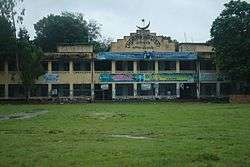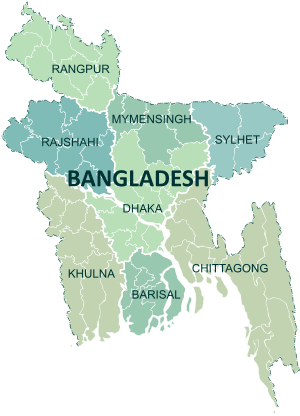Manikganj District
| Manikganj মানিকগঞ্জ | |
|---|---|
| District | |
 Location of Manikganj in Bangladesh | |
| Coordinates: 23°51′N 90°01′E / 23.85°N 90.01°ECoordinates: 23°51′N 90°01′E / 23.85°N 90.01°E | |
| Country |
|
| Division | Dhaka Division |
| Seat | 3 parliamentary seats |
| Area | |
| • Total | 1,383.66 km2 (534.23 sq mi) |
| Population (2011 census) | |
| • Total | 1,392,867 |
| • Density | 1,000/km2 (2,600/sq mi) |
| Literacy rate | |
| • Total | 56.0% |
| Time zone | UTC+6 (BST) |
| Postal code | 1800 |
| Website | http://www.manikganj.gov.bd |
Manikganj (Bengali: মানিকগঞ্জ [mɑnɪkˈɡondʒ]) is a district in central Bangladesh. It is a part of the Dhaka Division.[1]
History
Manikganj was formerly a subdivision of Dhaka District. It was turned into a district in 1984.
On 26 April 1989, Manikganj was the site of, what was at that time, the world's worst tornado in terms of loss-of-lives. 1,300 people were initially reported as having been killed with 12,000 injured. The towns of Saturia and Manikganj Sadar were leveled and about 80,000 people were made homeless.
War of Liberation
Liberation war in 1971 in Manikganj District was organized and led by Capt. Halim Chowdhury, Abdul Matin Chowdhury, Principal Abdur Rouf Khan and other heroes of the district.
During October 1971, at the Northwest corner of Bahadia village, Joymontop union in Singair upazila, a group of Freedom Fighters attacked the boats carrying the Pakistani intruding soldiers and a terrible battle occurred on the Dhaleshwari (canal). Eighty-two Pak soldiers were killed and 50 others held with injuries in a fierce battle with freedom fighters at Bahadia village in Singair upazila on October 28. Freedom fighters Mohidur Rahnan, Zahidur Rahman and Tobarak Hossain Ludu led the operation. None of the Mukti Bahini Freedom Fighters were killed during this battle which is one of the significant liberation fight against Pakistani military in Manikgonj. After this short duration battle, the Mukti Bahini Freedom Fighters leave the battle field and the PAK soldiers enhanced their strength bringing more soldiers and they touched 152 houses surrounding villages of the battle place and killed 6 local people who were mostly elderly stayed at home. In the last week of November in 1971, fresh groups of freedom fighters entered different areas of Manikganj and defeated Pakistani troops in a few battles. In 14 December 1971, a group of PAK Bahini moving toward Dhaka entered into Barundi village under Manikganj Sadar upazila, a group of liberation forces (Mujib Bahini) under leadership of Shahadat Hossain Biswas Badal were preparing to attack them within a suitable place. Understanding this, the PAK Soldiers immediately left the village leaving two soldiers from their troops. One of them was arrested by the liberation forces (Mujib Bahini) at night on 14 December 1971 and another was arrested by the same group of freedom fighters next day after a small fight. <Joymontop> Finally they declared the then sub-division (now Manikganj district) free on December 13.
Geography
Manikganj is a district in Dhaka Division. It comprises an area of 1,383.66 km2 (534.23 sq mi). Annual average temperatures reach a maximum of 36 °C and a minimum to 12.7 °C with the annual rainfall total being 2,376 mm (93.5 in).
Rivers
There are quite a few rivers in the Manikganj District.[2] The names of the some important rivers of this district are as follows:
- The Padma
- The Kaliganga
- The Jamuna
- The Dhaleshwari
- The Ichamati
Population
Manikganj District has a population of 1,671,985; 52.02% male and 56.34% female; the population density is 3674.
Economy
There are total 166 Haats and Bazars. Besides 54 fairs (Mela) are held in Manikganj. "Manikganj Bijoy Mela"-(Manikganj), "Bahadia Boishakhi Mela,(Bahadia) "Joymontop Modhor Mela,(Joymontop) Bahadia Bazar "Majhi Barir Mela"-(Diabari), "Zinda Shah Mela"-(Jhitka), "Belal/Billal Paglar Mela"-(Harganj), "Rowth Jatra Mela"-(Katigram), "Poush Mela"-(Atigram), "Bathaimuri Mela"-(Bathaimuri), "Baher Paglar Mela"-(Bangala), "Baher Paglar Mela"-(Mohadebpur), "Sadhur Mela"-( South Jamsha), "Sadhinota Mela"-(Maluchi), are famous and favorite all over Manikganj. Mohadebpur Bazar, Barangail Bazar, Baira Bazar, Jhitka Bazar, jamsha bazar, Diabari Bazar, Gheor Bazar, Singair Bazar, Bangala Bazar, Maluchi Bazar(Balla bazar) are famous bazar in manikganj.
Places of interest
- Baliati Zamindari Home, Saturia
 Baliati Palace
Baliati Palace Baliati Palace
Baliati Palace Baliati Palace - backside
Baliati Palace - backside
- Padmar Par, Harirampur
- Teota Jamindar Bari, Shibaloy
- Taota Noboratna Modh, Shibalaya
- Narayan Sadhur Asrom
- Historical Shrine and Mosque of Machaine Village
- Kabiraj Bari
Subdivisions
The upazilas are:
Religion
The district of Manikganj has 3575 mosques, 160 temples, 10 churches, five Buddhist temples and a pagoda.
Education
- Ibrahimpur Ishwar Chandra High School
- NPI University of Bangladesh
- National Polytechnic Institute, Manikganj
- Khan Bahadur Awlad Hossain College
- Barangail G.C High School
- Joymontop High School
- Diabari High School
- Government Debendra College
 Government Debendra College, Manikgonj
Government Debendra College, Manikgonj - Motilal Degree College, Daulatpur, Manikganj
- Kusherchar Ismail Hossain High School, Manikganj
- Bahadia High School
- Manikganj Model High School, South Seota
- Manikganj Govt. High School
- Manikganj Medical College
- S.K. Govt. Girls High School Manikgonj
- Baliati Iswar Chandra High School
- Hargaj Shahid Smriti High School
- Saturia Syed Kalu Shah University College Saturia
- Government Textile Vocational Institute Manikganj
- Golaidanga High School
- Jhitka A.M High School
- Patgram Anath Bandhu Government High School
- Nabarun High School
- Muljan High School
- Muljan Govt. Primary School
- Kalta Avoya Charan High School
- Kazi safi uddin dakhil madrasha
- U.C. High School, Dhalla
- Tilli High School
- Majir Uddin High School
Notable residents
- Begum Badrunnessa Ahmed-social activist and feminist
- Hiralal Sen, filmmaker
- Sourav Ganguly father's home is in Dankora, Saturia, Manikganj
- Momtaz Begum singer, Manikganj
- Shamsul Islam Khan (Ex- Minister ministry of Industry).
- Khan Ataur Rahman, Music composer, Singer, Music Director, Filmmaker, Actor.
- Munir Chowdhury, Educator, Dramatist and a martyr of Bangladesh War of Independence, was born in Manikganj.
- Naimur Rahman Durjoy, Cricketer.
- Khandaker Delwar Hossain, Politician.
- A K M Nurul Islam, 5th Vice President of Bangladesh
- Abdul Halim Chowdhury, Politician.
- Khandkar Manwar Hossain, Statistician, Educatior, Researcher.
- Maharani Hemanta Kumari Debi, Rani.
- Parbati Sankar Roy Choudhury, Zamindar of Teota.
- Mishuk Munier, Journalist.
- Sumita Devi, Actress, Filmmaker.
- Royal Bioscope Company, Company.
- Mohammad Ali Reza Khan, Bengal Presidency, British India.
- Dinesh Chandra Sen, Writer, Educationist and Researcher.
- Bangladesh Standard Time
- Bulbul Chowdhury, Artist, Dancer.
- Tareque Masud, Film director, Producer.
- Mohammad Kaykobad
- Ranadaprasad Saha, Businessman.
- Mir Quasem Ali, Businessman.
- Amarta Sen
- Muhammad Siddiq Khan
- Ramzan Ali RonyWriter
See also
References
| Wikimedia Commons has media related to Manikganj District. |
- ↑ Parvez Ali (2017). "Manikganj". In Parvez Ali and Ahmed A. Jamal. Banglapedia: National Encyclopedia of Bangladesh (Second ed.). Asiatic Society of Bangladesh.
- ↑ Bangladesh District Gazetteers:Manikganj. Government of Bangladesh. 1979, pp. 2–8
